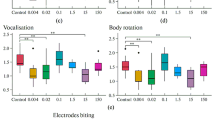Conclusions
-
1.
The process of the restoration of the function of the hypophyseal-gonadal system in baboons subjected to the prolonged administration of an LHRF agonist was characterized by the development of three principal phases, a latent phase, a phase of hyperfunction of the gonads, and a phase of return to the initial level of functioning.
-
2.
The duration of the phases was determined by the duration of the administration of the agonist and the individual characteristics of the functioning of the hypothalamic-hypophyseal-gonadal system.
-
3.
By contrast with the sex glands, the recovery of the gonadotropic function of the hypophysis did not undergo a stage of hyperfunction.
-
4.
The process of restoration of the adenohypophyseal function included the development of two phases of refractoriness of the D-basophilic adenocytes to exogenous LHRF which differ in the level of their functional activity.
-
5.
The recovery of the function of the hypophyseal-gonadal system in basal conditions preceded the recovery of the function of this system when it was activated.
Similar content being viewed by others
References
N. D. Goncharova and N. P. Goncharov,Probl. Endokrinol., No. 2, 62–67 (1989).
N. D. Goncharova, N. P. Goncharov, ibid, No. 5, 68–72 (1989).
N. P. Goncharov, G. V. Katsiya, N. D. Goncharova, et al.,A Kit of Reagents for the Radioimmunological Determination of Testosterone in Blood Plasma. Technical Specifications [TU] 42-17-86 [in Russian], Moscow (1986).
S. Bhasin, D. Heber, B. S. Steiner, et al.,J. Clin. Endocr.,60, 988–1003 (1985).
W. F. J. Growley, F. Comite, W. Vale, et al., ibid,52, 370–372 (1981).
N. P. Goncharov, A. V. Antonichev, V. M. Gorlushkin, et al.,Acta Endocr. (Kbh.),91, 49–58 (1979).
J. G. M. Klijn, F. H. De Jong, and M. A. Blankenstein,J. Endocr.,102, Suppl., 63 (1984).
A. V. Schally, A. Arimura, and D. H. Coy, in:Vitamins and Hormones, Vol. 38, P. L. Munson, et al. (eds.), New York (1980), pp. 258–324.
B. Warner, T. J. Worgul, J. Drago, et al.,J. Clin. Invest.,71, 1842–1853 (1983).
E. J. Wickings, M. H. Qazi, and E. Nieschlag,J. Reprod. Fertil.,57, 497–504 (1979).
S. S. C. Yen,Fertil. and Steril.,39, 257–266 (1983).
Author information
Authors and Affiliations
Additional information
Translated from Problemy Éndokrinologii, Vol. 37, No. 3, pp. 45–48, May–June, 1991.
Rights and permissions
About this article
Cite this article
Goncharova, N.D., Mkhitarova, L.A. & Gogiladze, É.M. The restoration of the function of the hypophyseal-gonadal system following its prolonged suppression by luliberin agonists. Neurosci Behav Physiol 23, 1–5 (1993). https://doi.org/10.1007/BF01182631
Received:
Issue Date:
DOI: https://doi.org/10.1007/BF01182631



